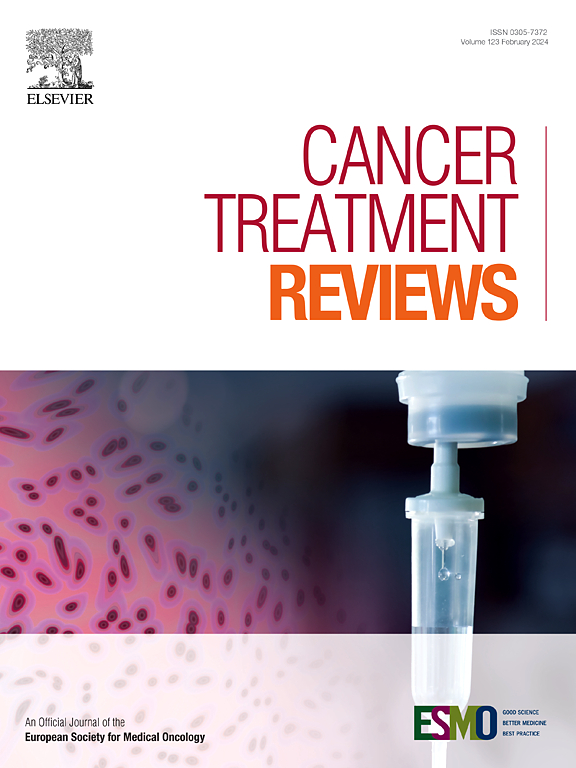Palliative systemic therapy for locally advanced or metastatic salivary duct carcinoma: A comprehensive review
IF 9.6
1区 医学
Q1 ONCOLOGY
引用次数: 0
Abstract
Salivary duct carcinoma (SDC) is a rare and highly aggressive malignancy of the salivary glands. For patients ineligible for curative surgery or definitive radiotherapy, treatment options remain limited owing to the absence of standardized therapeutic protocols. This review draws upon major salivary gland cancer guidelines and integrates molecular profiles with clinical response data to propose an evidence-based treatment algorithm that stratifies patients into four groups according to the expression status of human epidermal growth factor receptor 2 (HER2) and androgen receptor (AR).
In HER2-positive tumors, HER2-targeted therapy constitutes the standard of care, with trastuzumab plus docetaxel providing clinical benefit. Antibody-drug conjugates, such as trastuzumab deruxtecan, have demonstrated efficacy even in patients with disease progression during trastuzumab-based therapy. In AR-positive tumors, androgen deprivation therapy, particularly combined androgen blockade, has demonstrated clinical activity, though concurrent molecular characteristics may influence treatment outcomes.
In HER2-positive/AR-positive tumors, HER2-targeted therapy is generally prioritized, although the absence of validated predictive biomarkers and defined thresholds remains a clinical challenge. For HER2-negative and AR-negative tumors, or those refractory to either or both targeted approaches, cytotoxic chemotherapy remains a viable option. Immune checkpoint inhibitors may offer benefits in tumors with high PD-L1 expression, although data on their role in SDC remain limited. Next-generation sequencing is recommended to identify actionable alterations (e.g., NTRK, BRAF, FGFR, HRAS) that may guide targeted therapy or clinical trial enrollment. Integrating comprehensive molecular profiling into treatment decision-making is essential to optimizing outcomes in advanced SDC.

局部晚期或转移性唾液管癌的姑息性全身治疗:全面回顾
摘要唾液腺导管癌是一种罕见且高度侵袭性的恶性肿瘤。由于缺乏标准化的治疗方案,对于不符合治疗性手术或明确放疗条件的患者,治疗选择仍然有限。本综述借鉴了主要的唾液腺癌指南,结合分子图谱和临床反应数据,提出了一种基于证据的治疗算法,该算法根据人表皮生长因子受体2 (HER2)和雄激素受体(AR)的表达状态将患者分为四组。在her2阳性肿瘤中,her2靶向治疗构成了标准治疗,曲妥珠单抗加多西他赛提供了临床益处。抗体-药物结合物,如曲妥珠单抗德鲁西替康,即使在曲妥珠单抗治疗期间疾病进展的患者中也已证明有效。在ar阳性肿瘤中,雄激素剥夺疗法,特别是联合雄激素阻断疗法,已显示出临床活性,尽管同时存在的分子特征可能会影响治疗结果。在her2阳性/ ar阳性肿瘤中,通常优先考虑her2靶向治疗,尽管缺乏经过验证的预测性生物标志物和定义的阈值仍然是临床挑战。对于her2阴性和ar阴性肿瘤,或对其中一种或两种靶向方法都难治的肿瘤,细胞毒性化疗仍然是一种可行的选择。免疫检查点抑制剂可能在PD-L1高表达的肿瘤中提供益处,尽管关于其在SDC中的作用的数据仍然有限。新一代测序被推荐用于识别可操作的改变(例如,NTRK、BRAF、FGFR、HRAS),这些改变可能指导靶向治疗或临床试验的入组。将全面的分子谱分析整合到治疗决策中对于优化晚期SDC的预后至关重要。
本文章由计算机程序翻译,如有差异,请以英文原文为准。
求助全文
约1分钟内获得全文
求助全文
来源期刊

Cancer treatment reviews
医学-肿瘤学
CiteScore
21.40
自引率
0.80%
发文量
109
审稿时长
13 days
期刊介绍:
Cancer Treatment Reviews
Journal Overview:
International journal focused on developments in cancer treatment research
Publishes state-of-the-art, authoritative reviews to keep clinicians and researchers informed
Regular Sections in Each Issue:
Comments on Controversy
Tumor Reviews
Anti-tumor Treatments
New Drugs
Complications of Treatment
General and Supportive Care
Laboratory/Clinic Interface
Submission and Editorial System:
Online submission and editorial system for Cancer Treatment Reviews
 求助内容:
求助内容: 应助结果提醒方式:
应助结果提醒方式:


